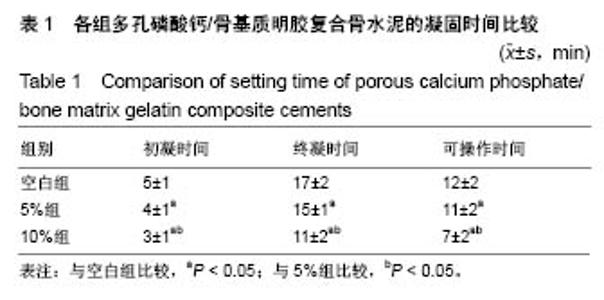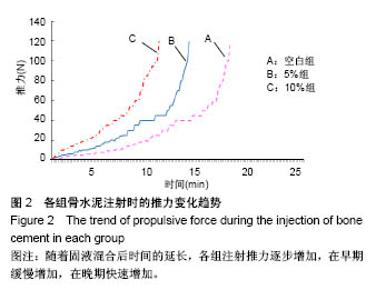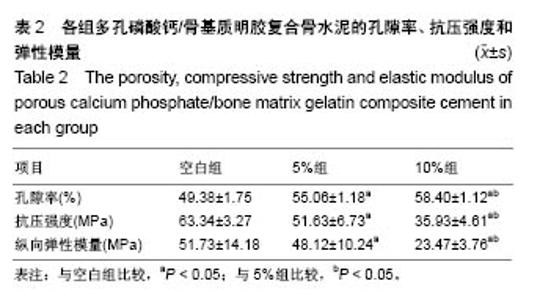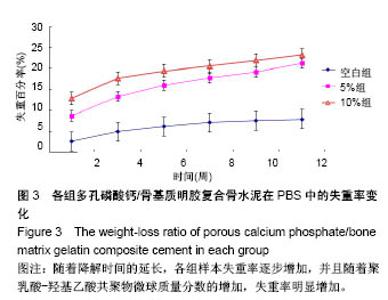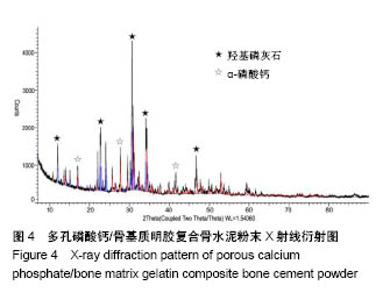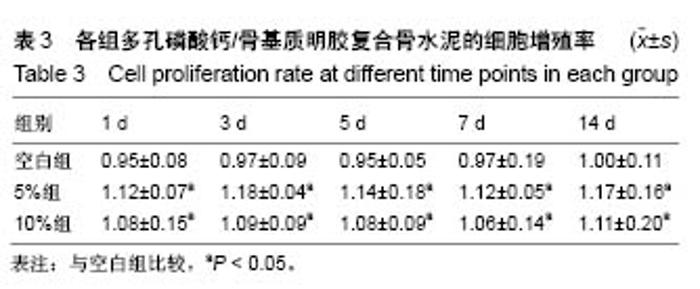Chinese Journal of Tissue Engineering Research ›› 2018, Vol. 22 ›› Issue (34): 5419-5425.doi: 10.3969/j.issn.2095-4344.0640
Previous Articles Next Articles
Development and physicochemical characterization of a porous calcium phosphate/bone matrix gelatin composite cement
Wang Song, Yang Han, Yang Jian, Zhang Kaiquan, Kang Jianping, Wang Qing
- The Affiliated Hospital of Southwest Medical University, Luzhou 646000, Sichuan Province, China
-
Received:2018-06-25Online:2018-12-08Published:2018-12-08 -
About author:Wang Song, MD, Associate chief physician, the Affiliated Hospital of Southwest Medical University, Luzhou 646000, Sichuan Province, China) -
Supported by:the Luzhou-Sichuan Medical University Joint Project, No. 2015LZCYD-S05; the Scientific Research Project of Sichuan Provincial Education Department, No. 18ZA05193D
CLC Number:
Cite this article
Wang Song, Yang Han, Yang Jian, Zhang Kaiquan, Kang Jianping, Wang Qing. Development and physicochemical characterization of a porous calcium phosphate/bone matrix gelatin composite cement[J]. Chinese Journal of Tissue Engineering Research, 2018, 22(34): 5419-5425.
share this article
| [1] O'Neill R,McCarthy HO,Montufar EB,et al.Critical review: Injectability of calcium phosphate pastes and cements.Acta Biomater.2016;9(16):30606-30607.[2] Liao H,Félix Lanao RP,van den Beucken JJ,et al.Size matters: effects of PLGA-microsphere size in injectable CPC/PLGA on bone formation.J Tissue Eng Regen Med. 2016;10(8): 669-678.[3] Urist MR,Lange RJ,Finerman GABone cell differentiation and growth factorsScience.1983; 220(4598):680-686.[4] Vrancken NM,Claeys AD.Method for encapsulating water and compoundsin aqueous phase by extraction: US, 3526906[P].1970-08-11.[5] 王松,杨函,杨剑,等.多孔磷酸钙/骨基质明胶复合骨水泥修复兔椎体骨缺损的研究[J].中国修复重建外科杂志, 2017,31(12): 1462-1467. [6] 丁裕明.新型磷酸钙复合骨水泥的制备及性能研究[D].泸州:西南医科大学,2016:1-9.[7] ISO.Cement-Test methods-Determination of setting time and soundness ISO 9597,2008.[8] ASTM.Standard test method for time of setting of hydraulic-cement paste by Gillmore needles. ASTM C266–08, 2008.[9] Habraken WJ,Wolke JG,Mikos AG,et al.PLGA microsphere/ calcium phosphate cement composites for tissue engineering: in vitro release and degradation characteristics.J Biomater Sci Polym Ed.2008;19(9):1171-1188.[10] 马思遥,杨帅兵,岳晓华.Wistar大鼠骨髓间充质干细胞的培养与鉴定[J].临床医药文献杂志,2018,85(3):24-26.[11] Khairoun I,Boltong MG,Driessens FC,et al.Effect of calcium carbonate on clinical compliance of apatitic calcium phosphate bone cement.J Biomed Mater Res. 1997;38(4): 356-360.[12] Medri V,Mazzocchi M,Bellosi A.Doped calcium-aluminium- phosphate cements for biomedical applications.J Mater Sci Mater Med.2011;22(2):229-236.[13] Shi M,Chen L,Wang Y,et al.Low-intensity pulsed ultrasound enhances antibiotic release of gentamicin-loaded, self-setting calcium phosphate cement.J Int Med Res. 2018;1: 300060518773023.[14] Bohner M.Design of ceramic-based cements and putties for bone graft substitution.Eur Cell Mater.2010;20:1-12.[15] Jang JH,Shin S,Kim HJ,et al.Improvement of physical properties of calcium phosphate cement by elastin-like polypeptide supplementation.Sci Rep.2018;8(1):5216.[16] Sarkar SK,Lee BY,Padalhin AR,et al.Brushite-based calcium phosphate cement with multichannel hydroxyapatite granule loading for improved bone regeneration.J Biomater Appl.2016; 30(6):823-837.[17] 张岩,郑欣,朱彦丞,等.微球在骨组织工程中的应用现状[J].中国矫形外科杂志,2016,24(16):1478-1481.[18] Gunnella F,Kunisch E,Maenz S,et al.The GDF5 mutant BB-1 enhances the bone formation induced by an injectable, poly(l-lactide-co-glycolide) acid (PLGA) fiber-reinforced, brushite-forming cement in a sheep defect model of lumbar osteopenia.Spine J.2018;18(2):357-369. [19] Gunnella F,Kunisch E,Bungartz M,et al.Low-dose BMP-2 is sufficient to enhance the bone formation induced by an injectable, PLGA fiber-reinforced, brushite-forming cement in a sheep defect model of lumbar osteopenia.Spine J. 2017; 17(11):1699-1711.[20] Liu W,Zhang J,Weiss P,et al.The influence of different cellulose ethers on both the handling and mechanical properties of calcium phosphate cements for bone substitution. Acta Biomater.2013;3:5740-5750.[21] Filipowska J,Pawlik J,Cholewa-Kowalska K,et al. Incorporation of sol-gel bioactive glass into PLGA improves mechanical properties and bioactivity of composite scaffolds and results in their osteoinductive properties.Biomed Mater. 2014;9(6):065001.[22] Santos PS,Cestari TM,Paulin JB,et al.Osteoinductive porous biphasic calcium phosphate ceramic as an alternative to autogenous bone grafting in the treatment of mandibular bone critical-size defects.J Biomed Mater Res B Appl Biomater. 2018;106(4):1546-1557.[23] 赵轶男,刘建,刘昌盛,等.不同孔径多孔CPC 材料修复兔大段骨缺损的实验研究[J].中国矫形外科杂志,2012,20(10):924-927.[24] 江捍平,王大平,阮建明,等.纳米羟基磷灰石人工骨的生物相容性研究[J].中国现代医学杂志,2005, 15(10):1477-1480.[25] 张红烨,张瑞生,夏永祥,等.磷酸钙骨水泥的生物相容性[J].中国组织工程研究与临床康复,2008,12(19):3713-3716.[26] Song Y,Zhang C,Wang P,et al.Engineering bone regeneration with novel cell-laden hydrogel microfiber-injectable calcium phosphate scaffold.Mater Sci Eng C Mater Biol Appl. 2017;75: 895-905.[27] Liu T,Li J,Shao Z,et al.Encapsulation of mesenchymal stem cells in chitosan/β-glycerophosphate hydrogel for seeding on a novel calcium phosphate cement scaffold.Med Eng Phys. 2018;56:9-15.[28] Lamghari M,Berland S,Laurent A,et al.Bone reactions to nacre injected percutaneously into the vertebrae of sheep. Biomaterials.2001;22(6):555-562.[29] Lamghari M,Antonietti P,Berland S,et al.Arthrodesis of lumbar spine transverse processes using nacre in rabbit.J Bone Miner Res.2001;16(6):2232-2237.[30] Parker RM,Malham GM.Comparison of a calcium phosphate bone substitute with recombinant human bone morphogenetic protein-2: a prospective study of fusion rates, clinical outcomes and complications with 24-month follow-up.Eur Spine J.2017;26(3):754-763.[31] Zheng YX,Wang J,Lin HT,et al.Reconstruction of orbital defect in rabbits with composite of calcium phosphate cement and recombinant human bone morphogenetic protein-2.Chin Med J (Engl). 2010;123(24):3658-3662.[32] Perrier M,Lu Y,Nemke B,et al.Acceleration of second and fourth metatarsal fracture healing with recombinant human bone morphogenetic protein-2/calcium phosphate cement in horses.Vet Surg.2008;37(7):648-655.[33] Palmer I,Nelson J,Schatton W,et al.Biocompatibility of calcium phosphate bone cement with optimised mechanical properties: an in vivo study.J Mater Sci Mater Med. 2016; 27(12):191.[34] Lovasik BP,Holland CM,Howard BM,et al.Anterior Cervical Discectomy and Fusion: Comparison of Fusion, Dysphagia, and Complication Rates Between Recombinant Human Bone Morphogenetic Protein-2 and Beta-Tricalcium Phosphate. World Neurosurg.2017;97:674-683.[35] Villavicencio AT,Burneikiene S.RhBMP-2-induced radiculitis in patients undergoing transforaminal lumbar interbody fusion: relationship to dose.Spine J.2016; 16(10):1208-1213.[36] Toth JM,Wang M,Lawson J,et al.Radiographic, biomechanical, and histological evaluation of rhBMP-2 in a 3-level intertransverse process spine fusion: an ovine study.J Neurosurg Spine. 2016;25(6):733-739. |
| [1] | Zhang Tongtong, Wang Zhonghua, Wen Jie, Song Yuxin, Liu Lin. Application of three-dimensional printing model in surgical resection and reconstruction of cervical tumor [J]. Chinese Journal of Tissue Engineering Research, 2021, 25(9): 1335-1339. |
| [2] | Zeng Yanhua, Hao Yanlei. In vitro culture and purification of Schwann cells: a systematic review [J]. Chinese Journal of Tissue Engineering Research, 2021, 25(7): 1135-1141. |
| [3] | Xu Dongzi, Zhang Ting, Ouyang Zhaolian. The global competitive situation of cardiac tissue engineering based on patent analysis [J]. Chinese Journal of Tissue Engineering Research, 2021, 25(5): 807-812. |
| [4] | Wu Zijian, Hu Zhaoduan, Xie Youqiong, Wang Feng, Li Jia, Li Bocun, Cai Guowei, Peng Rui. Three-dimensional printing technology and bone tissue engineering research: literature metrology and visual analysis of research hotspots [J]. Chinese Journal of Tissue Engineering Research, 2021, 25(4): 564-569. |
| [5] | Chang Wenliao, Zhao Jie, Sun Xiaoliang, Wang Kun, Wu Guofeng, Zhou Jian, Li Shuxiang, Sun Han. Material selection, theoretical design and biomimetic function of artificial periosteum [J]. Chinese Journal of Tissue Engineering Research, 2021, 25(4): 600-606. |
| [6] | Liu Fei, Cui Yutao, Liu He. Advantages and problems of local antibiotic delivery system in the treatment of osteomyelitis [J]. Chinese Journal of Tissue Engineering Research, 2021, 25(4): 614-620. |
| [7] | Li Xiaozhuang, Duan Hao, Wang Weizhou, Tang Zhihong, Wang Yanghao, He Fei. Application of bone tissue engineering materials in the treatment of bone defect diseases in vivo [J]. Chinese Journal of Tissue Engineering Research, 2021, 25(4): 626-631. |
| [8] | Zhang Zhenkun, Li Zhe, Li Ya, Wang Yingying, Wang Yaping, Zhou Xinkui, Ma Shanshan, Guan Fangxia. Application of alginate based hydrogels/dressings in wound healing: sustained, dynamic and sequential release [J]. Chinese Journal of Tissue Engineering Research, 2021, 25(4): 638-643. |
| [9] | Chen Jiana, Qiu Yanling, Nie Minhai, Liu Xuqian. Tissue engineering scaffolds in repairing oral and maxillofacial soft tissue defects [J]. Chinese Journal of Tissue Engineering Research, 2021, 25(4): 644-650. |
| [10] | Xing Hao, Zhang Yonghong, Wang Dong. Advantages and disadvantages of repairing large-segment bone defect [J]. Chinese Journal of Tissue Engineering Research, 2021, 25(3): 426-430. |
| [11] | Chen Siqi, Xian Debin, Xu Rongsheng, Qin Zhongjie, Zhang Lei, Xia Delin. Effects of bone marrow mesenchymal stem cells and human umbilical vein endothelial cells combined with hydroxyapatite-tricalcium phosphate scaffolds on early angiogenesis in skull defect repair in rats [J]. Chinese Journal of Tissue Engineering Research, 2021, 25(22): 3458-3465. |
| [12] | Wang Hao, Chen Mingxue, Li Junkang, Luo Xujiang, Peng Liqing, Li Huo, Huang Bo, Tian Guangzhao, Liu Shuyun, Sui Xiang, Huang Jingxiang, Guo Quanyi, Lu Xiaobo. Decellularized porcine skin matrix for tissue-engineered meniscus scaffold [J]. Chinese Journal of Tissue Engineering Research, 2021, 25(22): 3473-3478. |
| [13] | Mo Jianling, He Shaoru, Feng Bowen, Jian Minqiao, Zhang Xiaohui, Liu Caisheng, Liang Yijing, Liu Yumei, Chen Liang, Zhou Haiyu, Liu Yanhui. Forming prevascularized cell sheets and the expression of angiogenesis-related factors [J]. Chinese Journal of Tissue Engineering Research, 2021, 25(22): 3479-3486. |
| [14] | Liu Chang, Li Datong, Liu Yuan, Kong Lingbo, Guo Rui, Yang Lixue, Hao Dingjun, He Baorong. Poor efficacy after vertebral augmentation surgery of acute symptomatic thoracolumbar osteoporotic compression fracture: relationship with bone cement, bone mineral density, and adjacent fractures [J]. Chinese Journal of Tissue Engineering Research, 2021, 25(22): 3510-3516. |
| [15] | Liu Liyong, Zhou Lei. Research and development status and development trend of hydrogel in tissue engineering based on patent information [J]. Chinese Journal of Tissue Engineering Research, 2021, 25(22): 3527-3533. |
| Viewed | ||||||
|
Full text |
|
|||||
|
Abstract |
|
|||||


